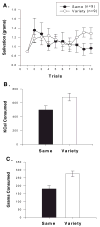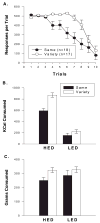Dietary variety impairs habituation in children
- PMID: 18248101
- PMCID: PMC2291292
- DOI: 10.1037/0278-6133.27.1.S10
Dietary variety impairs habituation in children
Abstract
Objective: The purpose of these studies was to test the hypothesis that dietary variety decreases the rate of habituation and increases energy intake in children.
Design: In Experiment 1, salivation in response to the same or a variety of food cues was measured followed by consumption of the study food(s). In Experiment 2, children responded in a computer task to earn points for the same or a variety of low or high energy density foods, which were then consumed.
Main outcome measures: Salivation, number of responses, and energy intake were measured.
Results: Participants in the same groups habituated faster than those in the variety groups (p = .05), and in Experiment 2, the effect of variety was independent of energy density. Participants in the variety groups also consumed more energy than those in the same groups in both experiments (p = .05).
Conclusions: Dietary variety disrupted habituation and increased energy intake in children. In addition, the response to dietary variety was independent of energy density, suggesting that increasing variety of low energy density foods may increase consumption.
(Copyright) 2008 APA.
Figures


References
-
- Adams MA, Pelletier RL, Zive MM, Sallis JF. Salad bars and fruit and vegetable consumption in elementary schools: A plate waste study. Journal of the American Dietetic Association. 2005;105:1789–1792. - PubMed
-
- Bell EA, Castellanos VH, Pelkman CL, Thowart ML, Rolls BJ. Energy density of foods affects energy intake in normal-weight women. American Journal of Clinical Nutrition. 1998;67:412–420. - PubMed
-
- Bell EA, Rolls BJ. Energy density of foods affects energy intake across multiple levels of fat content in lean and obese women. American Journal of Clinical Nutrition. 2001;73:1010–1018. - PubMed
-
- Berry SL, Beatty WW, Klesges RC. Sensory and social influences on ice cream consumption by males and females in a laboratory setting. Appetite. 1985;6:41–45. - PubMed
-
- Clifton PG, Burton MJ, Sharp C. Rapid loss of stimulus-specific satiety after consumption of a second food. Appetite. 1987;9:149–156. - PubMed
Publication types
MeSH terms
Grants and funding
LinkOut - more resources
Full Text Sources
Medical

